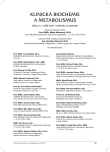Assessment of methylated derivatives of glycine in patients with metabolic syndrome and prediabetes
Authors:
V. Sudová; J. Racek; D. Rajdl; L. Trefil
Authors‘ workplace:
Ústav klinické biochemie a hematologie, Univerzita Karlova v Praze - Lékařská fakulta v Plzni a Fakultní nemocnice Plzeň
Published in:
Klin. Biochem. Metab., 27, 2019, No. 3, p. 107-111
Overview
Objective: The aim of our study was the implementation of HPLC method with UV detection for betaine and dimethylglycine in human plasma samples. Then quantification of these analytes in patients with metabolic syndrome and prediabetes and compare results between them and the control group.
Design: retrospective.
Settings: Department of Clinical Biochemistry and Hematology, Faculty of Medicine, Charles University and Faculty Hospital, Alej Svobody 80, 304 60 Pilsen (Czech Republic).
Material and methods: We developed the HPLC method on liquid chromatograph Thermo Separation Products Spectra SYSTEM (Thermo Fisher Scientific, Waltham, MA, USA) with these chromatographic conditions: mobile phase consisting of 90 % acetonitrile, 10 % water and 22 mmol/L choline; flow rate 1.5 ml/min; temperature 33 °C; UV detection in the wavelength 254 nm; column SUPELCOSILTM LC-SCX with particle size 5 µm. For implementation of method we used plasma samples of blood donors from transfusion department Faculty Hospital in Pilsen. The group consisted of 15 males and 15 females in the range of age of 39 to 61 years. The group with metabolic syndrome and prediabetes contained 12 males and 8 females in the range of age 36 to 67 years.
Results: Values of precision expressed as coefficient of variation were 10.6 % and 11.8 % for betaine and dimethylglycine. Intermediate precisions were 7.1 % and 12.3 %. Recovery of both analytes were 97.8 % for betaine and 97.7 % for dimethylglycine. Plasmatic concentrations of betaine and dimethylglycine in the control group were 135.8 ± 47.4 µmol/L and 4.7 ± 1.3 µmol/L. Plasmatic concentrations in patients with metabolic syndrome and prediabetes were 100.9 ± 40.9 µmol/L (significantly lower than in control group, p < 0.005) and 10.3 ± 6.2 µmol/L (significantly higher than in control group, p < 0.01). Plasma concentration of homocysteine in patients with metabolic syndrome was 14.4 ± 5.0 µmol/L (p < 0.001), in the control group 10.0 ± 3.5 µmol/L.
Conclusion: Patients with metabolic syndrome and prediabetes had lower plasma concentration of betaine and higher plasma level of dimethylglycine and homocysteine. These changes could be in relation with the development of non-alcoholic fatty liver disease and increased cardiovascular risk in these patients.
Keywords:
metabolic syndrome – betaine – dimethylglycine – HPLC.
Sources
1. Shuvalov, O., Petukhov A., Daks, A., Fedorova, O., Vasileva E., Barlev, N. A. One-carbon metabolism and nukleotide biosynthesis as attractive targets for anticancer therapy. Oncotarget, 2017, 8(14). ISSN 1949-2553. DOI: 10.18632/oncotarget.15053. Dostupné z: http://www.oncotarget.com/abstract/15053
2. Hyánek, J., Dubská, L., Pejznochová, H., Pehal, F., Vaingátová, S., Martiníková, V. Hyperhomocysteinémie – nepoznané, nepoznatelné a zanedbané (homocystein – užitečný marker methylačních poruch z deficitu holotranskobalaminu a folátu). Klinická biochemie a metabolismus, 2009, 17 (2), 2, p. 83-92.
3. Rajdl, D., Racek, J., Trefil, L., Stehlik, P., Dobra J., Babuska, V. Effect of Folic Acid, Betaine, Vitamin B6, and Vitamin B12 on Homocysteine and Dimethyl-glycine Levels in Middle-Aged Men Drinking White Wine. Nutrients, 2016, 8(1), 34, http://www.mdpi.com/2072-6643/8/1/34
4. Laryea, M. D., Steinhagen, F., Pawliczek, S., Wendel, U. Simple method for the routine determinativ of betaine and N,N-dimethylglycine in blood and urine. Clinical Chemistry. 1998, 44 (9), p. 1937-1941.
5. Holm, P. I., Ueland, P. M., Kvalheim, G., Lien, E. A. Determination of Choline, Betaine, and Dimethylglycine in Plasma by a High-Throughput Method Based on Normal-Phase Chromatography-Tandem Mass Spectro-metry. Clinical Chemistry. 2003, 49 (2), p. 286-294.
6. Kirsch, S. H., Herrmann, W., Rabagny, Y., Obeid, R. Quantification of acetylcholine, choline, betaine, and dimethylglycine in human plasma and urine using stable-isotope dilution ultra performance liquid chromatography–tandem mass spectrometry. Journal of Chromato-graphy B, 2010, 878 (32), p. 3338-3344.
7. Lever, M., George, M. G., Dellow, W. J., Scott, R. S., Chambers, S. T. Homocysteine, glycine betaine and N,N-dimethylglycine in patients attending a lipid clinic. Metabolism. 2005, 54 (1), p. 1-14.
8. Lever, M., Atkinson, W., Slow, S., Chambers, S. T., George, P. M. Plasma and urine betaine and dimethylglycin evariation in healthy young male subjects. Clinical Biochemistry. 2009, 42 (7-8), p. 706-712.
9. Lever, M., George, P. M., Atkinsons, W. Plasma Lipids and Betaine Do redakce došloAre Related in an Acute Coronary Syndrome Cohort. PLOS ONE, 2011, 6 (7), e21666.
10. McGregor D. O., Dellow, W. J., Lever, M., George, P. M., Robson, R. A., Chambers, S. T. Dimethylglycine accumulates in uremia and predicts elevated plasma homocysteine concentrations. Kidney International, 2001, 59 (6), p. 2267-2272.
11. Lever, M., George, P. M., Dellow, W. J., Scott, R. S., Chambers, S. T. Homocysteine, glycine betaine, and N,N-dimethylglycine in patients attending a lipid clinic. Metabolism [online]. 2005, 54 (1), p. 1-14.
12. Lever M., Slow, S., George, P. M., Chambers, S. T. Betaine excretion correlates with plasma homocysteine when plasma lipids are elevated. Clinical Biochemistry. 2012, 45(1-2), p. 154-156.
13. Lever, M., George, P. M., Elmslie, J. L. Betaine and Secondary Events in an Acute Coronary Syndrome Cohort. PLOS ONE, 2012, 7 (5), e37883.
Labels
Clinical biochemistry Nuclear medicine Nutritive therapistArticle was published in
Clinical Biochemistry and Metabolism

2019 Issue 3
Most read in this issue
- Laboratory diagnostics of patients with MGUS and results of their monitoring in a regional biochemical laboratory within 10 years
- XIV. celostátní sjezd České společnosti klinické biochemie
- Harmonization in clinical laboratories. Concepts and problems. Metrological continuity, standardization, harmonization
- HPV related deregulation of selected microRNAs in sinonasal squamous cell carcinoma
